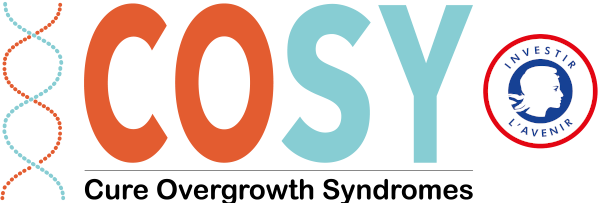Goals
The main goal is to achieve personalized medicine based on molecular diagnosis, new imaging modalities and innovative care for patients. Within this project, we will:
- Create affordable and state-of-art genetic testing to all patients (Partners: Imagine, AP-HP, ICM, IntegraGen)
- Develop new imaging software to precisely evaluate and follow patient malformations (Partners: AP-HP, HCL, Kitware, Eos Imaging)
- Transfer innovative care to existing expert centers (Partners: AP-HP, HCL)
- Understand the physiopathology of OS allowing patient stratification (Partners: Inserm, ICM)
- Envision new therapeutics for precision medicine (Partners: Inserm, ICM)
- Promote and communicate the knowledge (Partners: FFRD, Inserm, AP-HP)
- Improve the care, social condition and well-being of OS patients (Partners: Inserm, AP-HP, FFRD)
Strategy
1 – Understand the Physiopathology
In patients with OS, the mutation is not inherited but occurs during embryogenesis leading to somatic mosaicism which is responsible for an extremely heterogeneous clinical presentation. This broad clinical presentation, the absence of standardized genetic tests and our limited medical knowledge explain the unknown prevalence and incidence of these disorders.
Our strategy is to implement robust genetic diagnosis tools based on the research devices already used and understand the overgrowth physiopathology by combining complementary in vivo and in vitro approaches, new genetic mouse models, innovative new technology to explore the molecular and structural changes in OS, and to identify new treatment to purpose personalized medicine.
2 – Design a National Registry and Create Expert Centers
Currently, there is no available registry of OS, either nationally or internationally. As a consequence, the healthcare of these patients is not organized. Many medical specialties are potentially involved in the diagnosis and the follow up of these patients, but no dedicated centers are yet existing.
In response to this problem, we are determined to design the first national registry, enabling us to identifying optimal disease management strategies. Simultaneously, 4 multidisciplinary expert centers dedicated to OS patients will be establish in France, in this way OS patients will be provided with the best care where in a single day, they will have access to all physicians, surgeons, biopsy, DNA storage, and imaging. Our final purpose is to determine the OS incidence and define guidelines for patients care.
3 – Develop New Imaging Software
Radiological evaluation, including the initial diagnosis and the follow-up of patients with OS, is fundamental but complex. In order to characterize the overgrowth, patients often have multiple magnetic resonance imaging (MRI), but its interpretation is difficult. As a consequence, physicians do not have access to easy and reliable tools to use. In addition to MRI, patients have repeated X-rays for bone deformation and scoliosis monitoring, which may expose them to future cancer.
In the current strategy, we intend to establish new imaging modalities. To achieve this, we will develop a new device adapted to the patient with overgrowth to follow bones deformation and composition as well as a specific algorithm solution that will allow radiologists to easily and reproducibly evaluate patient malformations.
4 – Envision New Therapeutics for Precision Medicine
Currently, there are no specific treatments for patients with OS. The mechanisms of disease progression are unknown, also, mouse models to understand the physiopathology and explore pharmacological intervention, are dramatically lacking.
Our purpose is to open new therapeutic avenues. Based on our understanding of the physiopathology and the fact that the genes involved in OS are commonly mutated in cancer, we will reposition and/or repurpose drugs initially developed for oncology.
5 – Promote Communication and Improve Socialization
Finally, these disorders are associated with crippling disabilities resulting in deleterious social consequences characterized by a high rate of school drop out for children, desocialization and premature death.
We plan to reinforce the communication on these disorders in order to reach the maximum of OS patients in France and improve the socialization of these patients by applying the model developed at Necker-Enfants Malades hospital called “La suite” which is a new concept of care center where adolescent have access to social workers, estheticians, hairdresser, etc, with a view to better accept their body in the difficult period of transition to adulthood.
